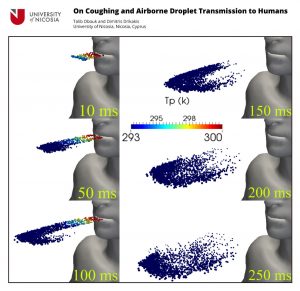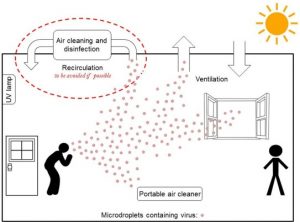Nowadays, in the current context of the coronavirus pandemic, everybody has a word to say about all the ways to limit, to control the spread of an airborne virus, but it’s been a subject of study for scientists for years. Several factors have to be considered to understand the spread: social distancing, time spent with the others, disinfection or hand washing. But we also can fight the spread by regulating air characteristics.
1- Means of transmission of the airborne virus
A new infection begins when a minimum dose of an infectious virus particle interacts with the human body. Furthermore, this quantity is a product of flow rate and exposure time. For example, a long period of weak exposition or a short period of severe exposition will imply the same dose of virus particles. The human body releases a certain number of droplets at different speeds depending on whether we sneeze, cough or speak for instance. The following illustration shows how droplets are transmitted by coughing (with the temperature of the droplets in kelvins).

We know that an indoor environment is often more dangerous for the human body for different reasons. The concentration of most pollutants are usually higher than outside. We bring materials, furnishings, appliances or activities into buildings and they release a variety of substances, some harmful, some not. Outdoors, the airflow is higher, the virus is more dispersed and reaches people less. Outdoor environment also has an effect on the properties of the virus. The protective coat of moisture is attacked by the sunrays, the wind and becomes weaker. For all those reasons, the virus is less dangerous for the human body outdoors, but we still have to be careful. In fact, as we spend most of the time indoors, and that it is harder to fight the spread of a virus in confined rooms, indoor climate has become a key factor.
But how can indoor climate control and avoid the spread of an airborne virus ?
2- The Psychrometrics of combating airborne viruses
2.1- The response to humidity
Many recent studies point out that climatic severity play a key role in the spread of the virus. In fact, cold and dry conditions accelerate the spread of coronavirus. The response of the virus to various indoor air conditions may be studied using the theory of respiratory droplets drying (the float time of bigger droplets is lower and therefore there is less risk for contamination). The droplets suspended in the air after sneezing or coughing have an initial temperature of 37°C and relative humidity going from 60 to 80%.
– In a cold and humid zone, there is no potential for the drying of droplets, but in order to reach the comfort zone, sensible heating will lead to size and weight reduction of the droplets and thus create a pocket for virus survival.
– In a hot and humid zone, when the air is conditioned, a reduction of the droplets density occurs, as a result, the droplet floats and becomes airborne.
– In a cold and dry zone, the initial drying potential is higher. In an environment with low humidity and low temperature, due to size reduction of the droplets, the virus is almost active in all the locations.
– In a hot and dry zone, cooling and dehumidification will increase the drying potential of the droplets, but cooling with humidification will improve the humidity degree and reduce the contamination risk.
These results have been derived using this psychrometric chart. The initial state of the droplets is plotted by points (DC1, DC2, DC3). We can identify the different zones discussed above (reference [2] for all values of the paragraph above).

2.2- The key role of ventilation
According to the recent announcements of ASHRAE, the potential airborne hazards have been acknowledged and ventilation control measures recommended. Ventilation plays a critical role in removing airborne virus, thus lowering the overall concentration of virus in the air inhaled by the occupants. Good ventilation practices are already in place in hospitals to fight against the spread of coronavirus, as it lowers the number of droplets in the air (the contaminated air is replaced by fresh outdoor air). One question subsists, how do we treat this contaminated air?
2.3- Management of clean and infected air through buildings
We have already seen how airflow in an enclosed space can be a concern as people can chat or sneeze, diffusing virus particles in almost all directions. Once we manage to control that, we still have a similar problem to deal with: after exiting the enclosed space, the virus still is a danger. For example, inside a building, the air coming out of one space must not enter another enclosed space as it is potentially infected. More precisely, keeping the virus in an enclosed space cannot allow it to diffuse as much as we would like to. In order to achieve that, we need to direct the potentially infected air flow towards more open spaces where the concentration can become insignificant way quicker.
3- Technical implementation
3.1- Outdoors
It’s complicated to manage the outdoor air quality. Nevertheless, as explained before, the concentration of infected air becomes insignificant in outdoor spaces. Therefore we can even be, more probably, safer compared to indoor spaces.
3.2- In indoor spaces
Unlike open spaces, we can manage the air quality in indoor spaces. Devices such as the ventilation system, air humidifiers and filters will help us to have an adequate indoor air quality, likewise an adequate activity management.
- Ventilation system :
The ventilation will play a key role combating the spread of airborne virus, an adequate ventilation rate, designed for a specific occupancy, will renovate the air and then remove the potential virus in the air. In order to save energy, an energy recovery system could be used. It exchanges the indoor air heat with outdoor air. It is more efficient compared to other systems.
- Air humidifiers :
As explained, relative humidity (RH) plays an important role in the evaporation of droplets and the distance they travel. An ideal indoor relative humidity is between 40% and 60% to prevent viral transmission at a room temperature. Some central humidifiers come equipped with hygrometers to determine the humidity in the space so that we can control if the humidity rate is adequate.
- Filters
The indoor air is more polluted than the air outside as we explained at the beginning. In general, two sources of clean air can be used to refresh indoor air: outside air and filtered air. Using high efficiency filters reduces particulate concentration for indoor air similar to outside air. Nevertheless, they require a regular cleaning or replacement. The principle of filters is to trap the viruses inside the air conducts before it arrives into another space. To do so, they contain fibrous or porous materials which can block the way for some kinds of particulates. They can also have a static electric charge which enables them to catch more of the concerned particulates.
- Activity management
Sometimes, the spaces in a building are used for other reasons than for which it was designed in the first place. As a consequence, HVAC systems are not adapted to supply the required ventilation and humidifying rate to keep an adequate indoor air quality. Many studies point that airborne infection risk increases because the spaces are overpopulated.
The following illustration shows a brief abstract of the technical means of combating the spread of an airborne virus indoors presented above.

Conclusion
We have seen that psychrometrics and the droplet theory help us to better understand the issue of airborne viruses. Hence, they allow us to control the major factors of indoor climate such as the humidity degree, the ventilation rate, regulate particulate concentration and thus supply the required air quality.
References :
-[1]Civil-212, Fundamentals of indoor climate, Prof Dusan Licina
-[2] The role of indoor climate in combating the spread of an airborne virus The contribution of dry indoor built environment on the spread of Coronavirus , Anthony Aroul Raj, Velraj R, Fariborz Haghighat, November 2020
-[3] Indoor air humidity, air quality and health Mechanistic insights into the effect of humidity on airborne influenza virus survival, transmission and incidence, Linsey Marr, Julian Tang, Jeniffer vam Mullekom, Seema Lakdawala, January 2019
-[4] How can indoor spread of covid 19 be minimised How can airborne transmission of COVID-19 indoors be minimised? September 2020
-[5] General article Indoor Environment and Viral Infections, Nicholas Clements, Matthew Binnicker, Veronique Roger, August 2020
-[6] HVAC and airborne viruses: separating fact from fiction
-[7] How coronavirus spreads outdoors vs. indoors
-[8] Ventilation example COVID-19 Outbreak Associated with Air Conditioning in Restaurant, Guangzhou, China, 2020,Jianyun Lu, Jieni Gu, Kuibiao Li, Conghui Xu, Wenzhe Su, Zhisheng Lai, Deqian Zhou, Chao Yu, Bin Xu and Zhicong Yang , July 2020
– [9]Technical methods to stop the spread of a virus How to use ventilation and air filtration to prevent the spread of coronavirus indoors, Shelly Miller, August 2020
Authors: Giboulot Axel, Apaza Yuly, Gaillard Tristan, Hatstatt Arthur